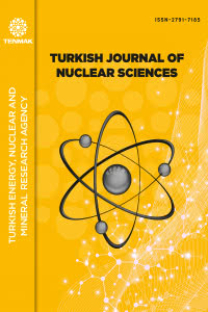Theoretical determination of neutron track detection efficiency at various neutron energies for CR-39 track detector
Yüklü parçacıkların sayımında katı hal nükleer iz detektörleri (SSNTDs) geniş çapta kullanılmaktadır. Nötronlar söz konusu ayırıcı katılarla etkileştiğinden plastik detektörün çekirdeğinde sayılabilir izler oluştururlar. Bu kapsamda, bu tip Detektörler nötronların indirekt olarak sayımında da kullanılabilirler. Bu çalışmada CR-39 iz detektörün Monte Carlo Nötron Foton (MCNA) transport kodu uygulanarak nötron iz sayımı verimi küresel geometride ele alınmıştır. Küresel ortam 2$mu$m kalınlığında eşmerkezli dilimlere ayrılmıştır. Bu kürenin merkezine belirli düzeyde tek enerjili nötron kaynağı yerleştirilmiştir. Her nötron enerjisi için MCNP kodu 7.5 milyon vaka için IBM kişisel bilgisayarında değerlendirilmiştir. Sonuçlar proton geri saçılmalarına (En>1.0 MeV için) ilaveten %50 oranında ki geri saçılmaların da oksijen ve karbon çekirdeklerinden kaynaklandığını göstermiştir. Nötron sayım verimi, nötron enerjisi 2.4 MeV ve daha fazla olduğu hallerde daima sabit kalmıştır ($10^{-5}$ mertebesinde). Çalışmanın bu teorik bölümü CR-39 nötron iz detektörleri ile sayımda verimin üst limitini vermektedir. Bu sonuçlar nötron dozimetrisinde önem arzetmektedir.
For the detection of charge particles, Solid State Nuclear Track Detectors (SSNTDs) are widely used. When neutrons interact with these insulating solids they leave detectable tracks through recoiling the consitutuent nuclei of the plastic detector as charge particles. Thus these detectors can also be used for the indirect detection of neutrons. In this research, a Monte Carlo Neutron Photon (MCNP) transport code has been employed to determine the neutron track detection efficiency of CR-39 was taken in the form of a sphere. The sphere was divided into concentric shells each of 2$mu$,m thickness. A mono energetic neutron source of particular energy was embedded in the center of this sphere. For each neutron energy, the code MCNP was run on an IBM compatible personal computer for 7.5 million histories. The results shows that in addition to the proton recoils (for En >1.0 MeV), about 50% recoils are due to Oxygen and Carbon nuclei. The neutron detection efficiency almost remains the same (in order of $10^{-5}$ when the neutron's energy is higher than the 2.4 MeV. This theoretical study gives an upper limit of the neutron track detection efficiency for CR-39 track detector. these results are useful in neutron dosimetry.
___
- Başlangıç: 1981
- Yayıncı: -
